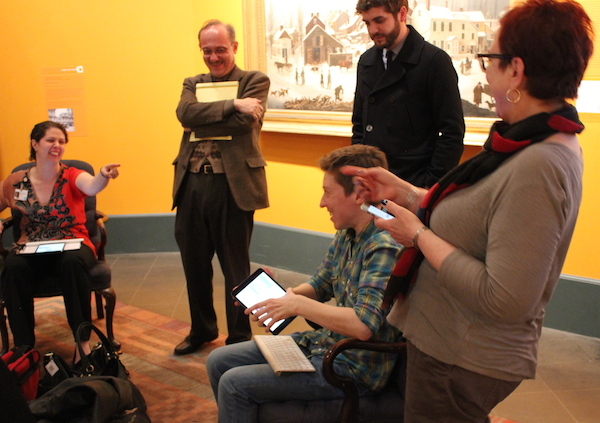Leveraging Technology for Connection
As Sara mentioned in her previous posts, we’ve been careful in this project to let visitor need pave the way toward an idea. It was especially important during our early pilots to stay away from technology and, instead, test basic concepts. Our pilots showed us visitors liked the idea of having access to someone who could help them and they wanted recommendations, but were seeking that in a way entirely dynamic to them.
You can imagine, this presented us with a bit of a conundrum because while we are going for “dynamic and responsive” in our own goals, how to do it sustainably is an incredible challenge. For starters, visitors liked the idea of access to a person, but we’d need a lot of staff to cover the 560,000 square feet of physical space we are dealing with. Next, if visitors want information responsive to them, we knew an algorithm just wouldn’t work. Almost anything that’s canned—whether provided by a computer taking its best shot or our own staff trying to do the same in any kind of pre-determined way—just didn’t own up to the spontaneity our visitors bring to the equation.
We started to realize that technology could help solve these issues by allowing us to consolidate the staff. If we created a centralized system to give visitors access to our experts, we could do it in a way that allows that staff to be omnipresent. We knew from past projects that visitors had incredibly valuable and meaningful questions, so what if we scaled this up a bit and gave access to experts via mobile devices throughout the museum instead (or with) iPad kiosks in selected locations?

In order to test quickly, we used off the self hardware in the form of iPod Touches, iPads, and iMessage.
We tested with a simple pilot to determine if having access to an expert on demand would be compelling solution. We invited a group of selected guests and then tested again with a group of random visitors and we used off the shelf hardware. Visitors were given iPod touches with iMessage and our Chief Curator, Kevin Stayton, acted as our expert fielding the incoming messages via an iPad. What we learned was compelling.

Staff helped type our Chief Curator’s responses into iPads during the pilot.
Participants lit up when they were told they could use the device to ask any question and get information, specific to them, on demand. As they used the system, they told us they engaged with the galleries in a more active fashion; they were thinking about things to ask and looking at galleries and art works more critically. In a total win for museum professionals everywhere, they reported (and were observed) looking more closely at art and did not feel sucked into the device’s screen. They felt as if the experience was a personal one, even with the hardware brokering their interaction with our expert.

Our pilot participants discussed the concept and their experiences after testing.
There were two additional findings that helped us see how incredibly compelling this solution could be. First, most of our visitors come in pairs or small groups and during our testing we were seeing people use the device socially if visiting with companions—questions were often phrased questions in the form of “we noticed” or “we’d like to know.” Second, participants independent of each other were observed asking similar questions about the same works of art. This interaction demonstrates potential gaps in interpretation and shows us the visitors with whom we interact digitally can give us a window into how well the other ways we communicate are working. This kind of digital engagement allows us to spot trends, which we can use to examine and make changes to analog content that will improve the visitor experience for everyone.

iMessage worked incredibly well and participants used the camera functionality in addition to texting.
This pilot led us to our project, which will be deployed in stages throughout the next three years. It starts with mobile, will continue with a physical presence throughout the museum, and be integrated back into our website. It provides a personal connection for visitors via mobile it leverages that connection back into the greater knowledge of the Museum.

Shelley Bernstein is the former Vice Director of Digital Engagement & Technology at the Brooklyn Museum where she spearheaded digital projects with public participation at their center. In the most recent example—ASK Brooklyn Museum—visitors ask questions using their mobile devices and experts answer in real time. She organized three award-winning projects—Click! A Crowd-Curated Exhibition, Split Second: Indian Paintings, GO: a community-curated open studio project—which enabled the public to participate in the exhibition process.
Shelley was named one of the 40 Under 40 in Crain's New York Business and her work on the Museum's digital strategy has been featured in the New York Times.
In 2016, Shelley joined the staff at the Barnes Foundation as the Deputy Director of Digital Initiatives and Chief Experience Officer.


Start the conversation